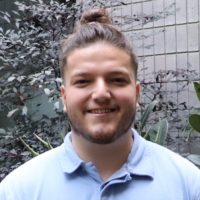
“Investigating water relations in OST1-silenced Nicotiana benthamiana plants with AquaDust”
Project Summary:
Capturing the effects of drought on plant water relations in real-time is challenging. However, a nanotechnology approach involving a dyed hydrogel known as AquaDust can be used to monitor the local water potential (ψ) within the apoplastic spaces of leaves. AquaDust, in combination with a gas exchange machine, can be used to measure the vapor pressure deficit (VPD), rate of transpiration (E), and rate of carbon assimilation (A) as metrics for plant growth and water use efficiency. Our goal was to explore the local water potential and hydraulic conductance in the xylem and mesophyll cells of mutated tobacco leaves. Virus-induced gene silencing (VIGS) protocols were implemented in Nicotiana benthamiana to knock down the expression of OST1, which encodes a protein that regulates stomatal closure. Four-week-old N. benthamiana plants were inoculated with tobacco rattle virus (TRV) to suppress the gene expression. The treatment group in this experiment consisted of the TRV genome with DNA fragments of our gene of interest (TRV-OST1). Three controls were used to determine whether the phenotype was affected by this treatment. One control, which was nonspecific to the genes in the N. benthamiana, was known as (TRV-GFP). The negative control was the (TRV-PQ-11-empty vector). The positive control (TRV-PDS) was used to determine how long it took for the inoculation to silence N. benthamiana’s gene expression by producing a bleaching phenotype. We studied how silencing OST1 gene expression prevented plants from closing their stomata. When the stomata remained open, we determined that the gas exchange mechanisms affected would trigger changes in the VPD and local water potential, which could then be investigated with AquaDust.
My Experience:
I am fortunate to have had the opportunity to learn and work in both Abe Stroock and Georg Jander’s labs, as part of the NSF-funded CROPPS project. I came to the Boyce Thompson Institute with minimal bioinformatics and molecular biology knowledge. However, because of the strong support network I encountered here, my critical thinking skills and problem-solving abilities grew to new heights. My mentors, Honglin Feng and Sabyasachi Sen, helped me gain a dynamic understanding of the molecular cloning processes, bioinformatics, and programmable plant systems used to carry out the experimental design and functional assays of our project. This ranged from learning virus-induced gene silencing protocols to generate mutated N. benthamiana tobacco plants with altered phenotypes to utilizing the AquaDust nanogel to take measurements at the molecular level within the leaves of living plants using a fiber-optic spectrometer. From this research experience, I gained the confidence to learn new things, ask questions, and envision opportunities as a plant researcher.
